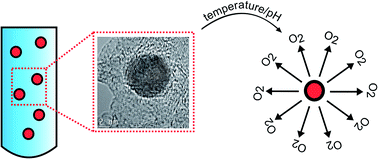Ultrasmall functional ZnO2 nanoparticles: synthesis, characterization and oxygen release properties†
Abstract
Ultrasmall zinc peroxide nanoparticles with diameter between 3.3 ± 0.9 and 14.4 ± 5.2 nm were synthesized by a simple and fast hydrothermal synthesis method. The precursor zinc acetate dihydrate was oxidized with hydrogen peroxide in aqueous media using a high-pressure impinging-jet reactor (MRT CR5, Microfluidics®). The combination of the high process pressure of 1400 bar and the special reaction chamber geometry minimized nanoparticle aggregation and limited the crystal growth, which resulted in very small and uniform particles. The zinc peroxide nanoparticles were in situ stabilized by bis[2-(methacryloyloxy)ethyl]phosphate providing excellent colloidal stability in water and integration of functional groups (polymerizable vinyl groups and adhesion-promoting phosphate groups). The obtained nanoparticles were characterized by XRD, TGA, TGA-MS, TEM, HR-TEM, Raman spectroscopy and zeta potential measurements. Furthermore the oxygen release from ZnO2 nanoparticles was analyzed. The oxygen release can be triggered by two different mechanisms: thermal decomposition in the dry state (T < 190 °C) and hydrolysis in water at pH < 8.


 Please wait while we load your content...
Please wait while we load your content...